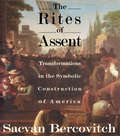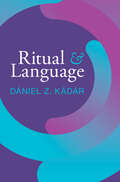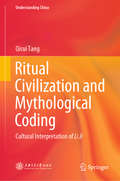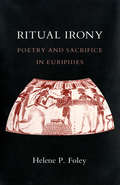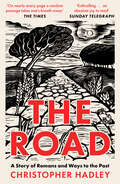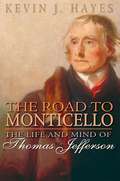- Table View
- List View
The Rites of Assent: Transformations in the Symbolic Construction of America
by Sacvan BercovitchThe Rites of Assent examines the cultural strategies through which "America" served as a vehicle simultaneously for diversity and cohesion, fusion and fragmentation. Taking an ethnographic, cross-cultural approach, The Rites of Assent traces the meanings and purposes of "America" back to the colonial typology of mission, and specifically (in chapters on Puritan rhetoric, Cotton Mather, Jonathan Edwards, and the movement from Revival to Revolution) to the legacy of early New England.
The Rites of Cricket and Caribbean Literature (New Caribbean Studies)
by Claire WestallThis book analyses cricket’s place in Anglophone Caribbean literature. It examines works by canonical authors – Brathwaite, Lamming, Lovelace, Naipaul, Phillips and Selvon – and by understudied writers – including Agard, Fergus, John, Keens-Douglas, Khan and Markham. It tackles short stories, novels, poetry, drama and film from the Caribbean and its diaspora. Its literary readings are couched in the history of Caribbean cricket and studies by Hilary Beckles and Gordon Rohlehr. C.L.R James’ foundational Beyond a Boundary provides its theoretical grounding. Literary depictions of iconic West Indies players – including Constantine, Headley, Worrell, Walcott, Sobers, Richards, and Lara – feature throughout. The discussion focuses on masculinity, heroism, father-son dynamics, physical performativity and aesthetic style. Attention is also paid to mother-daughter relations and female engagement with cricket, with examples from Anim-Addo, Breeze, Wynter and others. Cricket holds a prominent place in the history, culture, politics and popular imaginary of the Caribbean. This book demonstrates that it also holds a significant and complicated place in Anglophone Caribbean literature.
The Rites of Identity: The Religious Naturalism and Cultural Criticism of Kenneth Burke and Ralph Ellison
by Beth EddyThe Rites of Identity argues that Kenneth Burke was the most deciding influence on Ralph Ellison's writings, that Burke and Ellison are firmly situated within the American tradition of religious naturalism, and that this tradition--properly understood as religious--offers a highly useful means for considering contemporary identity and mitigating religious conflict. Beth Eddy adds Burke and Ellison to a tradition of religious naturalism that traces back to Ralph Waldo Emerson but received its most nuanced expression in the work of George Santayana. Through close readings of the essays and fiction of Burke and Ellison, Eddy shows the extent to which their cultural criticisms are intertwined. Both offer a naturalized understanding of piety, explore the psychological and social dynamics of scapegoating, and propose comic religious resources. And both explicitly connect these religious categories to identity, be it religious, racial, national, ethnic, or gendered. Eddy--arguing that the most socially damaging uses of religious language and ritual are connected to the best uses that such language has to offer--finds in Burke and Ellison ways to manage this precarious situation and to mitigate religious violence through wise use of performative symbolic action. By placing Burke and Ellison in a tradition of pragmatic thought, The Rites of Identity uncovers an antiessentialist approach to identity that serves the moral needs of a world that is constantly negotiating, performing, and ritualizing changes of identity.
The Rites of Identity: The Religious Naturalism and Cultural Criticism of Kenneth Burke and Ralph Ellison
by Beth EddyThe Rites of Identity argues that Kenneth Burke was the most deciding influence on Ralph Ellison's writings, that Burke and Ellison are firmly situated within the American tradition of religious naturalism, and that this tradition--properly understood as religious--offers a highly useful means for considering contemporary identity and mitigating religious conflict. Beth Eddy adds Burke and Ellison to a tradition of religious naturalism that traces back to Ralph Waldo Emerson but received its most nuanced expression in the work of George Santayana. Through close readings of the essays and fiction of Burke and Ellison, Eddy shows the extent to which their cultural criticisms are intertwined. Both offer a naturalized understanding of piety, explore the psychological and social dynamics of scapegoating, and propose comic religious resources. And both explicitly connect these religious categories to identity, be it religious, racial, national, ethnic, or gendered. Eddy--arguing that the most socially damaging uses of religious language and ritual are connected to the best uses that such language has to offer--finds in Burke and Ellison ways to manage this precarious situation and to mitigate religious violence through wise use of performative symbolic action. By placing Burke and Ellison in a tradition of pragmatic thought, The Rites of Identity uncovers an antiessentialist approach to identity that serves the moral needs of a world that is constantly negotiating, performing, and ritualizing changes of identity.
Ritsos in Parentheses
by Yannis Ritsos Edmund KeeleyPerhaps Greece's most important poet, Yannis Ritsos follows such eminent predecessors as Cavafy, Sikelianos, and Seferis in the dramatic and symbolic expression of a tragic sense of life. The three volumes of Ritsos's poetry translated here—Parentheses, 1946-47, Parentheses, 1950-61, and The Distant, 1975—represent a thirty year poetic journey and a developing sensibility that link the poet's subtler perceptions at different moments of his maturity. In his introduction to the poems, and as an explanation of the book's title, Edmund Keeley writes: "The two signs of the parenthesis are like cupped hands facing each other across a distance, hands that are straining to come together, to achieve a meeting that would serve to reaffirm human contact between isolated presences; but though there are obvious gestures toward closing the gap between the hands, the gestures seem inevitably to fail, and the meeting never quite occurs." In terms of the development of Ritsos's poetic vision, the distance within the parenthesis is shorter in each of the two earlier volumes than in the most recent volume. There the space has become almost infinite, yet Ritsos's powerfully evocative if stark landscape reveals a stylistic purity that is the latest mark of his greatness.Originally published in 1979.The Princeton Legacy Library uses the latest print-on-demand technology to again make available previously out-of-print books from the distinguished backlist of Princeton University Press. These editions preserve the original texts of these important books while presenting them in durable paperback and hardcover editions. The goal of the Princeton Legacy Library is to vastly increase access to the rich scholarly heritage found in the thousands of books published by Princeton University Press since its founding in 1905.
Ritual and Language
by null Dániel Z. KádárWhile ritual is often associated with phenomena such as ceremonies, cursing and etiquette, it actually encompasses something much more important: it includes all instances of communally oriented language use. As such, ritual manifests itself in many forms in our daily lives, such as politeness, swearing and humour, and in many different life situations, spanning trash talk in sports events, through market bargaining, to conventional social pleasantries. This pioneering book provides an introduction to ritual language use by providing a cutting-edge, language-anchored and replicable framework applicable for the study of ritual in different datatypes and languages. The framework is illustrated with a wealth of case studies drawn from Chinese and Anglophone rituals which demonstrate how to use it effectively. The book is essential reading for both academics and students, and is relevant to pragmatics, applied linguistics and other fields.
Ritual and the Idea of Europe in Interwar Writing
by Patrick R. QueryWhile most critical studies of interwar literary politics have focused on nationalism, Patrick Query makes a case that the idea of Europe intervenes in instances when the individual and the nation negotiate identity. He examines the ways interwar writers use three European ritual forms-verse drama, bullfighting, and Roman Catholic rite-to articulate ideas of European cultural identity. Within the growing discourse of globalization, Query argues, Europe presents a special, though often overlooked, case because it adds a mediating term between local and global. His book is divided into three sections: the first treats the verse dramas of T.S. Eliot, W.B. Yeats, and W.H. Auden; the second discusses the uses of the Spanish bullfight in works by D.H. Lawrence, Stephen Spender, Jack Lindsay, George Barker, Cecil Day Lewis, and others; and the third explores the cross-cultural impact of Catholic ritual in Graham Greene, Evelyn Waugh, and David Jones. While all three ritual forms were frequently associated with the most conservative tendencies of the age, Query shows that each had a remarkable political flexibility in the hands of interwar writers concerned with the idea of Europe.
Ritual and the Idea of Europe in Interwar Writing
by Patrick R. QueryWhile most critical studies of interwar literary politics have focused on nationalism, Patrick Query makes a case that the idea of Europe intervenes in instances when the individual and the nation negotiate identity. He examines the ways interwar writers use three European ritual forms-verse drama, bullfighting, and Roman Catholic rite-to articulate ideas of European cultural identity. Within the growing discourse of globalization, Query argues, Europe presents a special, though often overlooked, case because it adds a mediating term between local and global. His book is divided into three sections: the first treats the verse dramas of T.S. Eliot, W.B. Yeats, and W.H. Auden; the second discusses the uses of the Spanish bullfight in works by D.H. Lawrence, Stephen Spender, Jack Lindsay, George Barker, Cecil Day Lewis, and others; and the third explores the cross-cultural impact of Catholic ritual in Graham Greene, Evelyn Waugh, and David Jones. While all three ritual forms were frequently associated with the most conservative tendencies of the age, Query shows that each had a remarkable political flexibility in the hands of interwar writers concerned with the idea of Europe.
Ritual Civilization and Mythological Coding: Cultural Interpretation of Li Ji (Understanding China)
by Qicui TangThis book places Li Ji (the Book of Rites) back in the overall context of “books,” “rites” and its research history, drawing on the interrelations between myth, ritual and “materialized” symbols to do so. Further, it employs the double perspectives of “books” and “rites” to explore the sources and symbols of the capping ceremony (rites of passage), decode the prototypes of Miao and Ming Tang, and restore the discourse patterns of “people of five directions.” The book subsequently investigates the formation and function of the Yue Ling calendar and disaster ritual, so as to reveal the human cognitive encoding and metalanguage of ritual behavior involved. In the process, it demonstrates that Li Ji, its textual memories, archaeological remains and “traditional ceremony” narratives are all subject to the latent myth coding mechanism in China’s cultural system, while the “compilation” and “materialized” remains are merely forms of ritual refactoring, interpretation and exhibition, used when authority seeks the aid of ritual civilization to strengthen its legitimacy and maintain the social order.
The Ritual Culture of Victorian Professionals: Competing for Ceremonial Status, 1838-1877
by Albert D. PionkeFocusing on the middle decades of the nineteenth century, Albert D. Pionke's book historicizes the relationship of ritual, class, and public status in Victorian England. His analysis of various discourses related to professionalization suggests that public ritual flourished during the period, especially among the burgeoning ranks of Victorian professions. As Pionke shows, magazines, court cases, law books, manuals, and works by authors that include William Makepeace Thackeray, Thomas Hughes, Anthony Trollope, Charles Dickens, George Eliot, and Elizabeth Barrett Browning demonstrate the importance of ritual in numerous professional settings. Individual chapters reconstruct the ritual cultures of pre-professionalism provided to Oxbridge undergraduates; of oath-taking in a wide range of professional creation and promotion ceremonies; of the education, promotion, and public practice of Victorian barristers; and of Victorian Parliamentary elections. A final chapter considers the consequences of rituals that fail through the lens of the Eglinton tournament. The uneasy place of Victorian writers, who were both promoters of and competitors with more established professionals, is considered throughout. Pionke's book excavates Victorian professionals' vital ritual culture, at the same time that its engagement with literary representations of the professions reconstructs writers' unique place in the zero-sum contest for professional status.
The Ritual Culture of Victorian Professionals: Competing for Ceremonial Status, 1838-1877
by Albert D. PionkeFocusing on the middle decades of the nineteenth century, Albert D. Pionke's book historicizes the relationship of ritual, class, and public status in Victorian England. His analysis of various discourses related to professionalization suggests that public ritual flourished during the period, especially among the burgeoning ranks of Victorian professions. As Pionke shows, magazines, court cases, law books, manuals, and works by authors that include William Makepeace Thackeray, Thomas Hughes, Anthony Trollope, Charles Dickens, George Eliot, and Elizabeth Barrett Browning demonstrate the importance of ritual in numerous professional settings. Individual chapters reconstruct the ritual cultures of pre-professionalism provided to Oxbridge undergraduates; of oath-taking in a wide range of professional creation and promotion ceremonies; of the education, promotion, and public practice of Victorian barristers; and of Victorian Parliamentary elections. A final chapter considers the consequences of rituals that fail through the lens of the Eglinton tournament. The uneasy place of Victorian writers, who were both promoters of and competitors with more established professionals, is considered throughout. Pionke's book excavates Victorian professionals' vital ritual culture, at the same time that its engagement with literary representations of the professions reconstructs writers' unique place in the zero-sum contest for professional status.
Ritual Irony: Poetry and Sacrifice in Euripides
by Helene P. FoleyRitual Irony is a critical study of four problematic later plays of Euripides: the Iphigenia in Aulis, the Phoenissae, the Heracles, and the Bacchae.Examining Euripides' representation of sacrificial ritual against the background of late fifth-century Athens, Helene P. Foley shows that each of these plays confronts directly the difficulty of making an archaic poetic tradition relevant to a democratic society. She explores the important mediating role played by choral poetry and ritual in the plays, asserting that Euripides' sacrificial metaphors and ritual performances link an anachronistic mythic ideal with a world dominated by "chance" or an incomprehensible divinity.Foley utilizes the ideas and methodology of contemporary literary theory and symbolic anthropology, addressing issues central to the emerging dialogue between the two fields. Her conclusions have important implications for the study of Greek tragedy as a whole and for our understanding of Euripides' tragic irony, his conception of religion, and the role of his choral odes.Assuming no specialized knowledge, Ritual Irony is aimed at all readers of Euripidean tragedy. It will prove particularly valuable to students and scholars of classics, comparative literature, and symbolic anthropology.
Ritual Structures in Chicana Fiction (Literatures of the Americas)
by Helane AndroneThis book argues for the necessary and further examination of the sacred as it is ritualized within Chicana fiction. It suggests that religious, spiritual, linguistic and political symbolisms reveal rites that structure narrative performances of coping with and healing from trauma. Helane Androne examines these rites of spirit, service, and story as they occur in Ana Castillo’s So Far From God, Denise Chávez’s Face of An Angel, and Sandra Cisneros’ Caramelo. Beginning with the implications of Gloria Anzaldúa’s spiritual vision of Chicana identity alongside structural principles of ritual criticism, this study extends the discourse about the impact of the sacred in Chicana fiction. an>
The Rivals
by Jeremy RoweThis ebook is now available from Bloomsbury Academic. Bloomsbury Academic publish acclaimed resources for undergraduate and postgraduate courses across a broad range of subjects including Art & Visual Culture, Biblical Studies, Business & Management, Drama & Performance Studies, Economics, Education, Film & Media, History, Linguistics, Literary Studies, Philosophy, Politics & International Relations, Religious Studies, Social Work & Social Welfare, Study Skills and Theology. Visit bloomsbury.com for more information.
The River Fans Out: Literature and its Theories in China (China Academic Library)
by Yiheng ZhaoThis book presents 18 highly influential essays on Chinese literature and semiotics by Professor Zhao Yiheng, including his analysis and discussions of the development of Chinese literature and its characteristics from traditional to modern times. It is divided into three parts: traditional Chinese literature, contemporary Chinese literature, and semiotics. In the first part, Professor Zhao summarizes the core elements of narrative cultural relations, ethical dilemmas, and narrative features. He also provides a comprehensive description of the formal structures in Chinese traditional literature. Taking the traditional Chinese play White Rabbit as a case, he discusses the connections between the narrative structure and the characteristics of Chinese novels and stratification of Chinese culture.
River of Dissolution: D. H. Lawrence and English Romanticism (Routledge Library Editions: Romanticism)
by Colin ClarkeFirst published in 1969. This title concerns itself with the ambivalence of Lawrence’s attitude towards corruption. Clarke demonstrates that Lawrence’s attitude to ‘will’ and to sensational or disintegrative sex is much more equivocal than conceded. At the same time this is a study of Lawrence’s debt as a novelist to the English Romantic poets. A tradition of metaphor is traced from the second half of the eighteenth century, through the poetry of the major Romantics to the Decadents, and so to Lawrence, whose attitudes to mechanism and corruption are shown to be articulated, above all, through ambivalent images of dissolution and disintegration. This title will be of interest to students of literature.
River of Dissolution: D. H. Lawrence and English Romanticism (Routledge Library Editions: Romanticism)
by Colin ClarkeFirst published in 1969. This title concerns itself with the ambivalence of Lawrence’s attitude towards corruption. Clarke demonstrates that Lawrence’s attitude to ‘will’ and to sensational or disintegrative sex is much more equivocal than conceded. At the same time this is a study of Lawrence’s debt as a novelist to the English Romantic poets. A tradition of metaphor is traced from the second half of the eighteenth century, through the poetry of the major Romantics to the Decadents, and so to Lawrence, whose attitudes to mechanism and corruption are shown to be articulated, above all, through ambivalent images of dissolution and disintegration. This title will be of interest to students of literature.
The Road: A Story Of Romans And Ways To The Past
by Christopher HadleyA TIMES BOOK OF THE YEAR ‘An absolute joy to read and an early contender for every list of History Books of the Year’ Sunday Telegraph ‘On nearly every page a random passage takes one’s breath away’ The Times Have you ever heard the march of legions on a lonely country road?
ROAD-MAPPING English Medium Education in the Internationalised University
by Emma Dafouz Ute SmitThis book is the first to offer a conceptual framework of English-medium education that can be used across different international higher education (HE) contexts. It provides readers with an understanding of the complexities, possibilities and challenges that this phenomenon raises in the 21st century. Making the case for the pressing need for an overarching conceptualisation, the authors discuss, from a theoretical point of view, the recently introduced ROAD-MAPPING framework for ‘English Medium Education in Multilingual University Settings’ (EMEMUS). Drawing on current research and examples from a variety of settings, the book makes a strong case for the applicability of the framework in two important directions: as a methodological tool for researching educational practices and as an analytical guide to examine policies and teacher education programmes.
The Road of Excess: A History of Writers on Drugs
by Marcus BoonFrom the antiquity of Homer to yesterday's Naked Lunch, writers have found inspiration, and readers have lost themselves, in a world of the imagination tinged and oftentimes transformed by drugs. The age-old association of literature and drugs receives its first comprehensive treatment in this far-reaching work. Drawing on history, science, biography, literary analysis, and ethnography, Marcus Boon shows that the concept of drugs is fundamentally interdisciplinary, and reveals how different sets of connections between disciplines configure each drug's unique history. In chapters on opiates, anesthetics, cannabis, stimulants, and psychedelics, Boon traces the history of the relationship between writers and specific drugs, and between these drugs and literary and philosophical traditions. With reference to the usual suspects from De Quincey to Freud to Irvine Welsh and with revelations about others such as Milton, Voltaire, Thoreau, and Sartre, The Road of Excess provides a novel and persuasive characterization of the "effects" of each class of drug--linking narcotic addiction to Gnostic spirituality, stimulant use to writing machines, anesthesia to transcendental philosophy, and psychedelics to the problem of the imaginary itself. Creating a vast network of texts, personalities, and chemicals, the book reveals the ways in which minute shifts among these elements have resulted in "drugs" and "literature" as we conceive of them today.
The road to Brexit: A cultural perspective on British attitudes to Europe (Manchester University Press)
by Ina HabermannThis collection explores British attitudes to Continental Europe that explain the Brexit decision. Addressing British-European entanglements and the impact of British Euroscepticism, the book argues that Britain is in denial about the strength of its ties to Europe. The volume brings together literary and cultural studies, history, and political science in an integrated analysis of views and practices that shape cultural memory. Part one traces the historical and political relationship between Britain and Europe, whilst Part two is devoted to exemplary case studies of films as well as popular Eurosceptic and historical fiction. Part three engages with border mindedness and Britain’s island story. The book is addressed both to specialists in cultural studies, and a wider audience interested in Brexit.
The road to Brexit: A cultural perspective on British attitudes to Europe (Manchester University Press)
by Ina HabermannThis collection explores British attitudes to Continental Europe that explain the Brexit decision. Addressing British-European entanglements and the impact of British Euroscepticism, the book argues that Britain is in denial about the strength of its ties to Europe. The volume brings together literary and cultural studies, history, and political science in an integrated analysis of views and practices that shape cultural memory. Part one traces the historical and political relationship between Britain and Europe, whilst Part two is devoted to exemplary case studies of films as well as popular Eurosceptic and historical fiction. Part three engages with border mindedness and Britain’s island story. The book is addressed both to specialists in cultural studies, and a wider audience interested in Brexit.
The Road to Monticello: The Life and Mind of Thomas Jefferson
by Kevin J. HayesThomas Jefferson was an avid book-collector, a voracious reader, and a gifted writer--a man who prided himself on his knowledge of classical and modern languages and whose marginal annotations include quotations from Euripides, Herodotus, and Milton. And yet there has never been a literary life of our most literary president. In The Road to Monticello, Kevin J. Hayes fills this important gap by offering a lively account of Jefferson's spiritual and intellectual development, focusing on the books and ideas that exerted the most profound influence on him. Moving chronologically through Jefferson's life, Hayes reveals the full range and depth of Jefferson's literary passions, from the popular "small books" sold by traveling chapmen, such as The History of Tom Thumb, which enthralled him as a child; to his lifelong love of Aesop's Fables and Robinson Crusoe; his engagement with Horace, Ovid, Virgil and other writers of classical antiquity; and his deep affinity with the melancholy verse of Ossian, the legendary third-century Gaelic warrior-poet. Drawing on Jefferson's letters, journals, and commonplace books, Hayes offers a wealth of new scholarship on the print culture of colonial America, reveals an intimate portrait of Jefferson's activities beyond the political chamber, and reconstructs the president's investigations in such different fields of knowledge as law, history, philosophy and natural science. Most importantly, Hayes uncovers the ideas and exchanges which informed the thinking of America's first great intellectual and shows how his lifelong pursuit of knowledge culminated in the formation of a public offering, the "academic village" which became UVA, and his more private retreat at Monticello. Gracefully written and painstakingly researched, The Road to Monticello provides an invaluable look at Jefferson's intellectual and literary life, uncovering the roots of some of the most important--and influential--ideas that have informed American history.
The Road to Somewhere: A Creative Writing Companion
by Robert Graham Helen Newall Heather LeachThis revised, updated and expanded new edition of The Road to Somewhere will help you to acquire the craft and disciplines needed to develop as a writer in today's world. It is ideal for anyone - student writers, writing teachers and seasoned authors - seeking practical guidance, new ideas and creative inspiration. The Road to Somewhere: A Creative Writing Companion, second edition offers:- new chapters on writing for digital media, flash fiction, memoir, style and taking your writing out into the world- updated chapters on fiction, scripts, poetry, and experimental forms- an examination of creative processes and advice on how to read as a writer - many practical exercises and useable course materials- extensive references and suggestions for further reading- information on how to get work published or produced, in real and virtual worlds- tips on how to set up and run writing workshops and groups - a complete Agony Aunt section to help with blocks and barriers - guidance on the more technical aspects of writing such as layout and grammar.And, to lighten your writing journey a little, we've tried to make this second edition even wittier and smarter than the first. So whether you see yourself as a published professional or a dedicated dabbler, this is the book to take along for the ride.
The Road to Somewhere: A Creative Writing Companion
by Robert Graham Helen Newall Heather LeachThis revised, updated and expanded new edition of The Road to Somewhere will help you to acquire the craft and disciplines needed to develop as a writer in today's world. It is ideal for anyone - student writers, writing teachers and seasoned authors - seeking practical guidance, new ideas and creative inspiration.The Road to Somewhere: A Creative Writing Companion, second edition offers:- New chapters on writing for digital media, flash fiction, memoir, style and taking your writing out into the world- updated chapters on fiction, scripts, poetry, and experimental forms- An examination of creative processes and advice on how to read as a writer - Many practical exercises and useable course materials- Extensive references and suggestions for further reading- Information on how to get work published or produced, in real and virtual worlds- Tips on how to set up and run writing workshops and groups- A complete Agony Aunt section to help with blocks and barriers- Guidance on the more technical aspects of writing such as layout and grammarAnd, to lighten your writing journey a little, we've tried to make this second edition even wittier and smarter than the first. So whether you see yourself as a published professional or a dedicated dabbler, this is the book to take along for the ride.
